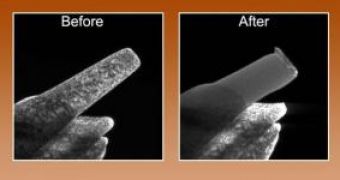You silly... you were thinking about sex again, weren't you? However, we're talking about nanostructures, so let's get to it! You would usually think that metal structures, especially on the nanoscale, would be rather fragile and could easily be destroyed; however, this is not entirely true. As metal structures approach the micrometer scale or even less, they get even stronger. This phenomena has been eluding scientists for more than half a century, ever since the first experiments involving measuring the strength of thin metal wires only a few micrometer in diameter were conducted.
During all this time, multiple theories have been conceived in order to explain the phenomena, but the fact is that only recently scientists have been able to view the processes that take place during stressing small structures.
In order to finally reveal the mystery behind the increased strength of the metal nanostructures, scientists developed an experiment that used nickel nanorods with diameters between 150 to 400 nanometers, which were compressed with the help of a punch dye made out of diamond, and videotaped the whole experiment with a transmission electron microscope.
According to their results, the metal nanostructure presents defects in the crystal lattice, the so-called dislocation planes that present plastic deformation patterns. Usually, the macroscopic mechanical deformations have a tendency to increase the dislocation number, however nanoscale structures seem to behave differently, mainly due to the fact that the ratio between the surface area of the structure is greater than that of the volume, causing fully dislocated nickel rods to close while subjected to mechanical pressure, which results in a perfect crystal lattice.
Unlike the first metal nanostructures created for the first time in the middle of the 20th century, which were made by growing crystals, the tested nanostructures have been built by using a focused ion beam that produces two types of defects: part relatively shallow defects produced by the crystal growing technique, and part pre-existing defects in the crystal lattice, which where both eliminated during the compression phase of the experiment.
Andrew Minor, from the Materials Sciences Division in the Department of Energy's Lawrence Berkeley National Laboratory, that took part in the experiment, explains that the nanostructure can be made stronger if the defects can be eliminated before they interact with each other and multiply, even though they are not enough to cause an imposed deformation process.
Furthermore, the scientists asked themselves what would happen if the compression of the structure continued. They suggested that when stress is applied even further, there would appear new defects in the material that would cause it to encounter one of the multiple outcomes, such as twisting, flattening or shearing of the nickel nanorod due to plastic deformation.
Nevertheless, while experimenting with pillars of 300 nanometers diameter, the compression method was not completely successful, leaving behind still visible defects in the structures, but still presented increased strength and the defect appearance process, during the progressive pressure test.

 14 DAY TRIAL //
14 DAY TRIAL //